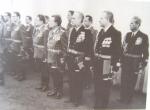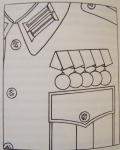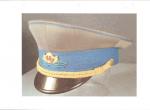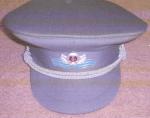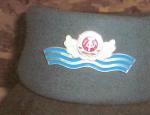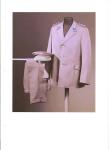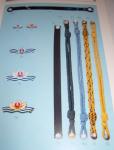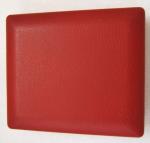-
Posts
4,808 -
Joined
-
Last visited
-
Days Won
12
Everything posted by Gordon Craig
-

DDR Wasserwirtschaft
Gordon Craig replied to Paul R's topic in Germany: Post 1945: Bundesrepublik & DDR
Time now for me to post the uniform inmy collection This uniform is for the Stellvertreter des Ministers, as indicated by the shoulderboards, from 1976 until 1981 when the title for this position was changed to Generaldirector. The number two position in the organization. Since there are no books on the uniforms for this organization and almost no photographs I have taken a guess at the shirt and tie as they are portrayed. The cap cord differs from that shown in the reference book I have used but it is the hat that came with the uniform and does not appear to have been altered in anyway. Regards, Gordon -

DDR Medal Bar
Gordon Craig replied to Grant Broadhurst's topic in Germany: Post 1945: Bundesrepublik & DDR
-

DDR Medal Bar
Gordon Craig replied to Grant Broadhurst's topic in Germany: Post 1945: Bundesrepublik & DDR
Now a couple of photographs that point out the "but" part of what Uwe said. First one is of Oberst der VP a.D. Hans Kohoutek. -

DDR Medal Bar
Gordon Craig replied to Grant Broadhurst's topic in Germany: Post 1945: Bundesrepublik & DDR
-

DDR Medal Bar
Gordon Craig replied to Grant Broadhurst's topic in Germany: Post 1945: Bundesrepublik & DDR
Now lets leap ahead to the 80s which is the era that most collectors are familiar with. At least as far as pictures of awards being worn goes. This drawing points out what UWE said re the Gesellschaft in wear on parade. It also shows how the IS would have been worn with this uniform. -

DDR Medal Bar
Gordon Craig replied to Grant Broadhurst's topic in Germany: Post 1945: Bundesrepublik & DDR
-

DDR Medal Bar
Gordon Craig replied to Grant Broadhurst's topic in Germany: Post 1945: Bundesrepublik & DDR
-

DDR Medal Bar
Gordon Craig replied to Grant Broadhurst's topic in Germany: Post 1945: Bundesrepublik & DDR
Gents, SPEEDYTOP has done a great job in reducing a complex subject to a few words. A lot less words than it would take me. To add to his description and to some of my own comments lets look at some regs over the years of the DDR. The following drawings are based on regulations as printed in DV 010/0/005. These drawings do not hold true for all forms of dress in that specific period. I am trying to indicate what was probably the most awards worn in any single row of a medal bar and how it changed over time. Lest start with the 50s; -

Hungary Nine Years ago Today
Gordon Craig replied to hunyadi's topic in Central & Eastern European States
Charles, What a super item to add to your collection. Now I know what to ask for the next time Dorothy asks me what I want for my birthday. To late for our Wedding Anniversary as it has past for this year. Happy Anniversary. We wish you and Jennie many more. Regards, Gordon -

DDR Wasserwirtschaft
Gordon Craig replied to Paul R's topic in Germany: Post 1945: Bundesrepublik & DDR
This next cap is the second, and last type of peaked cap, worn by the Wsserwirtschaft. The cap badge and chin cords indicate it would be worn by someone of Minister rank. Regards, Gordon -

DDR Wasserwirtschaft
Gordon Craig replied to Paul R's topic in Germany: Post 1945: Bundesrepublik & DDR
The first type peaked cap worn by the Wasserwirtschaft. This cloth peaked cap did not hold its shape very well. I have two in my collection, both with different chin cords, and neither one looks very good because of their lack of ability to retain their shape. This pictured example is unusual in this respect. -

DDR Wasserwirtschaft
Gordon Craig replied to Paul R's topic in Germany: Post 1945: Bundesrepublik & DDR
-

DDR Wasserwirtschaft
Gordon Craig replied to Paul R's topic in Germany: Post 1945: Bundesrepublik & DDR
-

DDR Wasserwirtschaft
Gordon Craig replied to Paul R's topic in Germany: Post 1945: Bundesrepublik & DDR
Gents, Here are some pictures of Wasserwirtschaft uniforms from my files. The first picture is of a uniform from the Deutschen Historischen Museum (DHM) in Berlin. -

DDR Medal Bar
Gordon Craig replied to Grant Broadhurst's topic in Germany: Post 1945: Bundesrepublik & DDR
Ulsterman, The only time awards were restructed to four was when you were wearing a shirt and no tunic. Then only four ribbons could be worn on your ribbon bar. At different times the number of awards worn on one bar changed from a maximum of four to a maximum of six. Also, how multiple awards were worn also changed over the course of the DDR. I have that all written up some where and if I can find it I'll post it here. Not sure that I have a soft copy with me. Getting ready for family company to arrive on Friday but will try and find time to post something on the regs on wearing awards on medal bars tomorrow. Cheers, Gordon -

DDR Wasserwirtschaft
Gordon Craig replied to Paul R's topic in Germany: Post 1945: Bundesrepublik & DDR
Paul R, I don't know how effective they were. I think they would like to have been effective but wading through the Communist bureaucratic mess must have been almost impossible. Especially with the Russian troops changing the oil in their vehicles and just letting it drain out onto the ground. Germans are by nature clean, neat and tidy and keeping their water clean would have been something that they would have wanted to do. All conjection on my part but I like to think that they wanted to look after their country and not just wear a uniform to parade around in. Cheers, Gordon -

DDR Wasserwirtschaft
Gordon Craig replied to Paul R's topic in Germany: Post 1945: Bundesrepublik & DDR
Gents, I need to correct my earlier post. I do have the information that I asked SPEEDYTOP for. Here it is. There are actually seven different colours; Yellow-Ministry Personnel Green-Water Service Directorate Green w/navy buttons-Water Service Directorate (boat personnel) Turquoise-Water Service Local Offices Red-Water Management Department Orange-Water Service Technical Schools Grey-Water Project Supervisory Service Black-Machinist and Maintenance Service -

DDR Wasserwirtschaft
Gordon Craig replied to Paul R's topic in Germany: Post 1945: Bundesrepublik & DDR
SPEEDYTOP, According to my reference material there were five different colours of underlay on the shoulderboards. They were; Hellgr?n Rot Orange Hellgrau Schwarz What I do not know is what these different colour signified. Was it different branches of the organization related to their job function? Regards, Gordon -

DDR Wasserwirtschaft
Gordon Craig replied to Paul R's topic in Germany: Post 1945: Bundesrepublik & DDR
SPEEDYTOP, Thanks for the correction on the date of the Ministerium and the name of the predecessor. Nothing in print in English on this organization so it is great to have your input. Paul R. No idea how many people were involved nor if all of those who worked for the Ministerium were uniformed. There may have been a small uniformed contingent and a civilian clothed section was well. I say a small uniformed contingent because of the small number of Wasserwirtschaft uniforms that seem to be available. There is a lot of Wasserwirtschft insignia available on ebay.de and most of it has got to be repro. There is just too much of it to be real. Thanks for starting the thread. I expect we will learn a lot from it. Regards, Gordon -

DDR Medal Bar
Gordon Craig replied to Grant Broadhurst's topic in Germany: Post 1945: Bundesrepublik & DDR
Gents, While this may look like a bar for an under achiever that does not necessarily follow. It could represent only part of the awards worn by one individual. It could well be the lower bar for a larger set with more awards worn above it. Always nice to see a ribbon bar preserved and added to a collection. Regards, Gordon -

DDR Wasserwirtschaft
Gordon Craig replied to Paul R's topic in Germany: Post 1945: Bundesrepublik & DDR
Gents, Kevin is correct. The Wasserwirtschaft was not a policing organization. They were involved in clean water, water management, wet lands preservation etc. They were often placed in commercial firms to make sure they treated water correctly during the manufacturing process. Their uniforms are not common. The Ministerium fur Umweltschutz und Wasserwirtschaft came into being in 1976. Their original uniform accessories only lasted for 76/77 and then some changes were made. These changes stayed in effect until the dissolltion of the DDR in 1999. Here is a picture of the cap cords and cap badges worn by the Wasserwirtschaft. Cap cord #77 was only worn in 76/77. In the photo, cap cord 80a looks blue but is is actually silver. The different cap cords were worn for different positions held. Shoulder boards and the stars on them indicated a position held and not an actual rank although they did indicate a more senior position within the Ministerium or the firm where they held a post. It is impossible to list all the possible positions held for each shoulderboard and star combination because I would have to reproduce the entire book to do that. I can say that the sold gold cord was worn only by the Minster and the gold cord with the blue flecks was worn by the Staatssecretar and the Stellvetreter des Ministers positions. Regards, Gordon -
Alex, Nice hats. Particularly the "crusher". I'd be interested in seeing the labels inside of these hats. Authentic "crushers" are rare and normally date from the 50's. Regards, Gordon
-

DDR DDR / East German Reference Books Data Base
Gordon Craig replied to Paul R's topic in Germany: Post 1945: Bundesrepublik & DDR
SPEEDYTOP, Nice rare books you have there. Something I will have to look for. Regards, Gordon -
Gents, There is an earlier dating system that I had but cannot find at the moment. Can someone else post it please. It is relavant for eary uniforms not for hats. Before the four digit number were issued to manufacturers they often used their names in hats. Cheers, Gordon
-

Hungary Hungarian Red Cross Awards
Gordon Craig replied to Gordon Craig's topic in Central & Eastern European States



